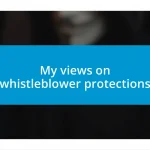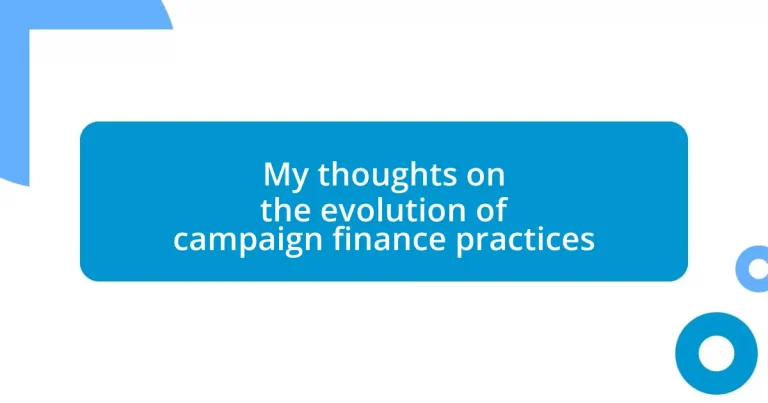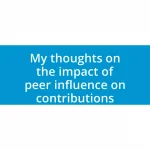Key takeaways:
- The Citizens United (2010) Supreme Court ruling allowed unlimited corporate and union spending, significantly altering campaign finance dynamics.
- The historical progression of campaign finance includes key milestones like the Tillman Act (1907) prohibiting corporate contributions and the Federal Election Campaign Act (1971) establishing donor disclosure requirements.
- Digital fundraising has revolutionized campaign financing, fostering grassroots movements but also raising sustainability concerns against larger funding sources.
- Transparency and compliance in campaign finance remain critical issues, with challenges in ensuring accurate disclosure of donor influences on candidates.
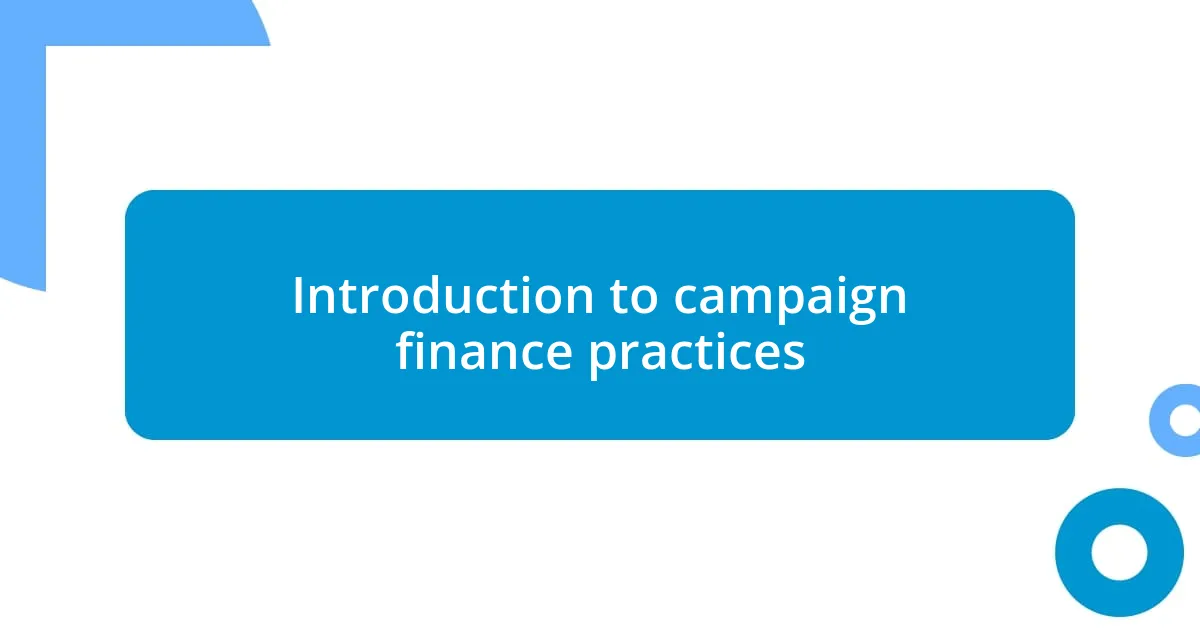
Introduction to campaign finance practices
Campaign finance practices are at the core of how political candidates fund their aspirations and connect with voters. When I first learned about these practices, I was surprised by the sheer amount of money involved. It’s fascinating to think about how financial support can shape political landscapes and influence decisions that affect us all.
In my experience, navigating the world of campaign finance often feels like a complex maze. Have you ever considered how the financial backing behind a candidate might impact their policies and priorities? I’ve found that understanding the sources of a candidate’s funding can provide significant insight into the values they hold and the interests they prioritize.
What truly intrigues me is the evolution of these practices over time. Reflecting on past election cycles, I notice how changes in legislation, like the Citizens United decision, have transformed fundraising strategies. It’s a bit unsettling to think that the influx of anonymous donations can skew public trust and the democratic process itself. How have these shifts in campaign finance shaped your perception of the electoral process? I know they’ve certainly influenced mine.

Historical overview of campaign finance
Campaign finance has a long and storied history in the United States, evolving significantly from its early days. I remember first diving into the roots of this system, finding it fascinating how, in the late 19th century, informal practices dominated political fundraising. Candidates relied heavily on personal connections, which created a more intimate Political funding landscape, though it often led to excessive influence from wealthy individuals and corruption.
Here are some key milestones in the historical overview of campaign finance:
- 1907: The Tillman Act prohibited corporate contributions to federal campaigns, marking one of the first attempts to regulate campaign finance.
- 1971: The Federal Election Campaign Act (FECA) established comprehensive regulations, including limits on contributions and the requirement for candidates to disclose their donors.
- 2010: The Citizens United ruling by the Supreme Court allowed corporations and unions to spend unlimited amounts on independent political expenditures, fundamentally shifting the funding landscape.
Reflecting on these changes, it’s striking how they mirror broader societal values and power dynamics. As I explore these historic shifts, I can’t help but feel a mix of admiration and concern. While strides toward transparency were made, the rise of super PACs and dark money illustrates a more complex and potentially alarming narrative today. The complexities draw me in, making me wonder about the long-term implications for our democracy and the role money plays in shaping our political future.
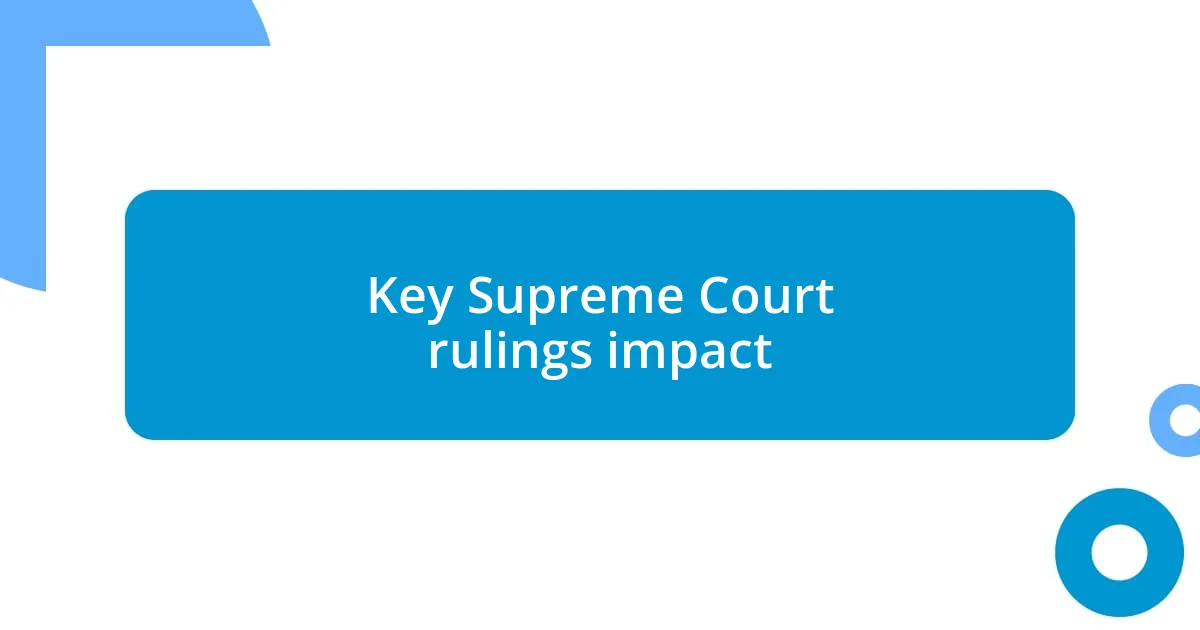
Key Supreme Court rulings impact
The impact of key Supreme Court rulings on campaign finance is profound and multifaceted. For instance, after the Citizens United decision, I noticed an astonishing increase in funding sources for campaigns. The ability for corporations and unions to spend freely fundamentally shifts how candidates approach fundraising. It’s a game-changer—one that often leaves me questioning where loyalty truly lies with these candidates. Are they truly representing the voters, or are they beholden to the interests that fill their coffers?
Similarly, I’m struck by the McCutcheon v. FEC ruling. It allowed individuals to contribute to as many candidates or committees as they wish, which, in my experience, can lead to a concentration of political power in the hands of a few. I remember feeling uneasy hearing about billionaires influencing elections, as it shifts the balance of power away from the average voter. One has to wonder, how does this affect public policy when the voice of the common citizen seems smaller in comparison to a mega-donor?
These legal changes paint a picture of a campaign finance landscape that continuously evolves and raises questions about fairness and transparency. I often reflect on how these rulings impact my own beliefs about participation in democracy. When I consider the implication of allowing unrestricted funds, it makes me worry about the future of equitable representation in politics. How can we ensure that everyone’s voice is heard if money talks louder than it should?
| Supreme Court Ruling | Impact on Campaign Finance |
|---|---|
| Citizens United v. FEC (2010) | Allowed unlimited spending by corporations and unions, leading to a surge in super PACs and anonymous donations. |
| McCutcheon v. FEC (2014) | Eliminated aggregate limits on individual contributions, enabling wealthier donors to fund multiple candidates. |
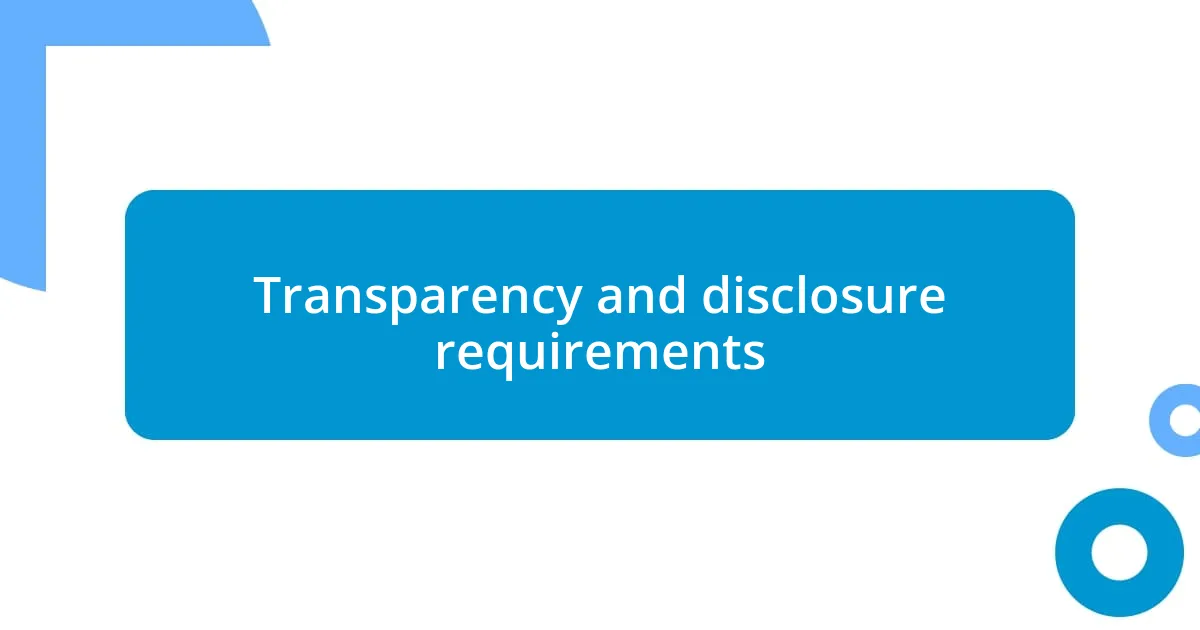
Transparency and disclosure requirements
Transparency in campaign finance often feels like a balancing act between openness and the complexities of political fundraising. I recall the first time I learned about disclosure requirements; the idea that candidates must reveal their donors sparked a sense of hope in me. It’s a step toward accountability, but it can still feel like a puzzle to piece together. Who is really funding these campaigns, and how do they influence the political landscape?
While I appreciate the existence of these requirements, there’s a nagging concern about compliance and enforcement. I remember attending a town hall meeting where the subject came up, and I was struck by how many people were still in the dark about where campaign money was truly coming from. It left me wondering: can we trust that the information being provided is both complete and accurate? In a world where dark money can easily slip through the cracks, the quest for genuine transparency becomes increasingly daunting.
Moreover, I often think about the emotional weight of these disclosures. Imagine being a candidate pouring your heart into a campaign, only to find out that a significant portion of your funding comes from entities that don’t align with your values. That personal conflict must be overwhelming. How can a candidate stay true to their principles when the stakes are so high? As I reflect on this, I realize the vital role strong transparency laws play in not just protecting the integrity of campaigns, but also in safeguarding the very essence of democratic ideals.

Digital fundraising and technology’s role
The shift to digital fundraising has transformed how candidates connect with potential donors. I remember first witnessing the power of social media during a local election; candidates were not just asking for support but creating a community around their campaigns. This immediacy allowed for real-time engagement that traditional fundraising methods simply couldn’t match—so what does that mean for grassroots movements? Are they being revitalized or overshadowed by larger, wealthier organizations leveraging the same digital platforms?
Using technology in fundraising has also created a more democratized approach. I once contributed to a campaign through a crowdfunding platform and felt directly involved in shaping the candidate’s journey. This level of accessibility empowers average citizens to engage financially, yet it raises questions about the sustainability of such models. Can small contributions truly compete against the juggernauts that can mobilize massive resources in seconds?
As I analyze these shifts, the emotional aspect of digital fundraising stands out to me. With every campaign email and social media post, candidates are creating personal connections that can evoke a sense of urgency and belonging. I recall receiving a heartfelt video message from a candidate thanking their supporters, which inspired me to share their campaign with my network. But does the effectiveness of these genuine appeals weaken as they become more automated and less personal over time? The risk of losing that authentic touch is something I think we all need to ponder as technology continues to play a dominant role in campaign finance.










